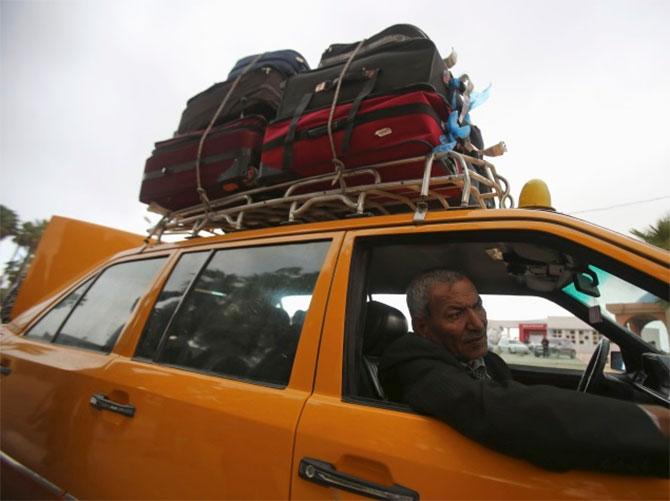Ola’s cash reserves are starting to run dry. The company was in talks to raise $1 billion in funding by the end of July, but no announcement has been made as yet

Bhavish Aggarwal, bottom, left, co-founder and CEO of India’s largest taxi aggregator Ola, was forced to take the hard step of laying off close to 700 employees and shutting down TaxiForSure in his bid to cut operational costs and conserve the company’s dwindling cash reserves.
Ola had acquired smaller rival TaxiForSure for $200 million in March last year, and after investing in its growth for exactly a year, began diverting resources from its subsidiary to grow itself. In the fight to stay ahead of Uber, Ola transitioned all TaxiForSure cabs to its own Micro category, where prices start at Rs 6 a km, and claimed that its low-fare service was larger than all of Uber India.
“When Ola started transitioning cabs from TaxiForSure to its Micro category sometime around March this year, several employees began quitting because they were preempting a shutdown,” says an ex-TaxiForSure employee who quit before Ola shut down its subsidiary. “Basically, by laying off everyone who had not yet quit, they were cutting operational costs,” he adds.
The cost of price war
The growing cash burn hastened the decision. Uber, which entered the Indian market just three years ago, began a price war with Ola by heavily subsidising the cost of rides for customers and paying large incentives to drivers. Ola, which has so far kept up with Uber in terms of fares, considered it more prudent to cut operational costs of an almost-defunct TaxiForSure than jeopardise its market position by slashing discounts.
However, while huge discounts have drawn customers to its platform (soon after it was acquired, daily rides for TaxiForSure shot up from 10,000 to 40,000), it has also led to increase in cash burn for the company.
 By shutting down TaxiForSure, Ola will save an estimated Rs 30 crore (Rs 300 million) just on salaries, a sizable amount that can be deployed elsewhere, given that the company’s reserves are starting to run dry. Business Standard had earlier reported that Ola was in talks to raise $1 billion in funding by the end of July. However, no announcement has been made as yet, pointing to a delay.
By shutting down TaxiForSure, Ola will save an estimated Rs 30 crore (Rs 300 million) just on salaries, a sizable amount that can be deployed elsewhere, given that the company’s reserves are starting to run dry. Business Standard had earlier reported that Ola was in talks to raise $1 billion in funding by the end of July. However, no announcement has been made as yet, pointing to a delay.
At the same time, the company’s losses have widened from Rs 34.21 crore (Rs 342 million) in 2013-14 to Rs 796 crore (Rs 7.96 billion) in 2014-15. The 2015-16 results are yet to be disclosed.
“In the course of the integration, we have absorbed as many TaxiForSure employees for open roles in Ola to support our growth. For positions that cease to exist as a result of this transition, we are offering enhanced severance benefits and outplacement services to help affected employees pursue new career opportunities,” the company had said in a statement soon after shutting down TaxiForSure.
Most of the employees who were absorbed came from a technical background, while the majority of people in other roles were laid off. When Ola first announced that it was acquiring TaxiForSure last year, the fate of the company was sealed, since it made no sense for Ola to run both companies and share a double burden especially since both of them operated in the same market.
"Ola acquired TaxiForSure only for its loyal customer base which it slowly transitioned on to its own platform by allowing them to book Ola cabs on the TaxiForSure app,” says the former TaxiForSure employee who pleaded anonymity.
Fight for dominance
In the battle against well-funded Uber, the Indian company is doing its best to reduce cash burn and make its resources last for as long as possible, hopefully by then deterring Uber from being as aggressive as it is today.
At the start of this month, San Francisco-based Uber sold off its China unit to rival Didi Chuxing as it saw its market share growth stall despite burning nearly $2 billion in three years. The company, which forayed into the Indian and Chinese markets in the same month in 2013, has in many ways been able to make a much larger impact in India.
Both Uber and Ola claim market leadership. However, according to research firm Redseer Consulting, Ola continues to dominate with nearly two-thirds of the market, while Uber controls about a fourth. Ola might be in the lead, but Uber in the past has displayed its ability to grow swiftly.
In the end, both companies follow a business model that ensures that the player with the larger number of cabs or passengers on its platform will win. Experts say that in India, where the market lacks maturity and customers ply with whichever player offers the lowest fare, growing either of those metrics is directly proportional to the amount of money each company is willing to burn.
With Uber accepting defeat in China, it’s all the more important for the company to ensure that it wins in India, the last large open market globally. This will put more pressure on Ola, as Uber can now divert funds that would have otherwise gone into its China business to India.
The company has already said that it will be investing a significant portion of the $3.5 billion it raised from Saudi Arabia’s Public Investment Fund in its India business. The battle for dominance in India’s taxi-hailing market is likely to get fiercer.
Image used for representation purpose only.
Photograph: PTI Photo.










 © 2025
© 2025